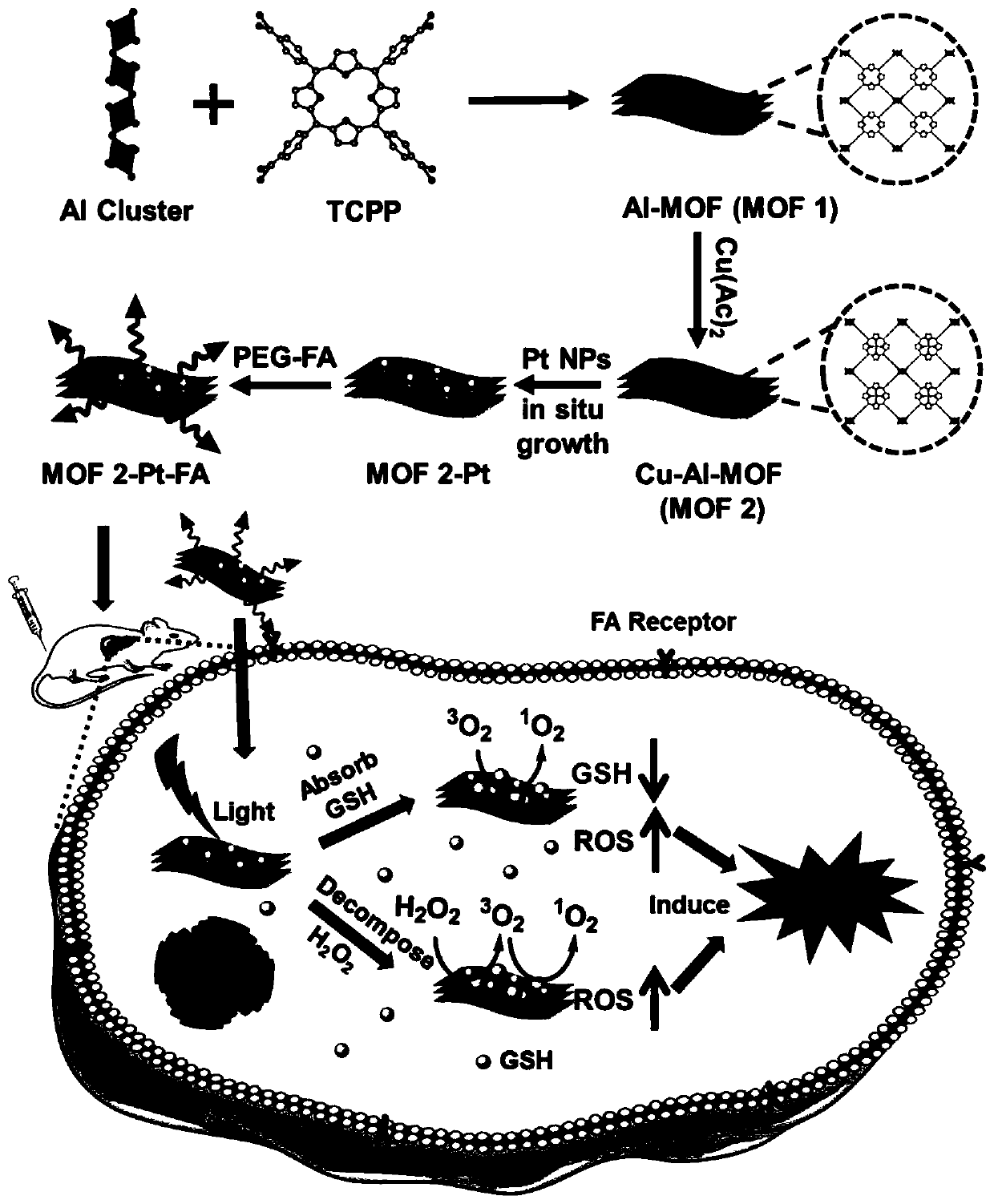Synthesis of platinum-modified MOF 2-Pt-FA as two-way enhanced photodynamic therapy drug, and application of platinum-modified MOF 2-Pt-FA in tumor treatment
A mof2-pt-fa, mof2-pt technology, applied in the application field of bidirectionally enhanced photodynamic therapy drugs in tumor treatment, can solve the problem of easy aggregation and light-induced quenching, poor targeting and aggregation ability, and unsatisfactory treatment effect. and other problems, to achieve the effect of enhancing the efficiency of PDT, mild synthesis conditions, and improving the effect of PDT
- Summary
- Abstract
- Description
- Claims
- Application Information
AI Technical Summary
Problems solved by technology
Method used
Image
Examples
Embodiment 1
[0036] Example 1: Synthesis of MOF 2
[0037] AlCl 3 ·6H 2 A mixture of O (0.0125 mmol), cetyltrimethylammonium bromide (CTAB) (1 mmol) and TCPP (0.063 mmol) was dissolved in 5 mL of water and then added to 20 mL of polytetrafluoroethylene at 180 °C Ethylene-lined autoclave for 16 hours. Purple nanoparticles were obtained by centrifugation and washed three times with DMF, H2O and acetone. This product is referred to as MOF1. Thereafter, MOF 1 (170 °C under vacuum, overnight) (10 mg) and Cu(Ac) 2 ·H 2 A solution of O (0.08 mmol) in 2 mL of DMF was added to a 20 mL Teflon-lined autoclave at 100 °C for 24 h. The product was collected by centrifugation and washed sequentially with DMF, H 2 O and acetone washes 3 times. Store the obtained MOF 2 particles dry.
[0038] figure 2 (A) shows the TEM image of the synthesized nanoparticle MOF 2 with a size of 100–200 nm; figure 2 (C) shows the XRD image of the synthesized nanoparticle MOF 2 together with the simulated image....
Embodiment 2
[0039] Example 2: Synthesis of MOF 2-Pt
[0040] The specific steps for the synthesis of MOF 2-Pt were to combine MOF 2 nanoparticles (0.05 g) and H 2 PtCl 6 (20 mM, 1 mL) in 20 mL of water was stirred at room temperature for 1 h. Next, add 2 mL of NaBH to the solution 4 (4 mg mL -1 ), followed by vigorous stirring for 3 hours. Finally, the product was centrifuged and washed 3 times with water. The product is called MOF 2-Pt.
[0041] figure 2 (B) shows the TEM image and high-resolution lattice image of the synthesized nanoparticle MOF 2-Pt, with platinum nanoparticles ranging in size from 2 to 5 nm; figure 2(C) shows the XRD image of the synthesized nanoparticle MOF 2-Pt.
Embodiment 3
[0042] Example 3: Synthesis of MOF 2-Pt-FA
[0043] 1 mL of MOF 2-Pt nanoparticles (1 mg mL -1 ) solution with 50 μL FA-PEG-COOH (5 mg mL -1 ) was stirred at room temperature for 30 minutes. The obtained MOF 2-Pt-FA was subjected to centrifugation and then dispersed in water for further use.
PUM
 Login to View More
Login to View More Abstract
Description
Claims
Application Information
 Login to View More
Login to View More - R&D
- Intellectual Property
- Life Sciences
- Materials
- Tech Scout
- Unparalleled Data Quality
- Higher Quality Content
- 60% Fewer Hallucinations
Browse by: Latest US Patents, China's latest patents, Technical Efficacy Thesaurus, Application Domain, Technology Topic, Popular Technical Reports.
© 2025 PatSnap. All rights reserved.Legal|Privacy policy|Modern Slavery Act Transparency Statement|Sitemap|About US| Contact US: help@patsnap.com



